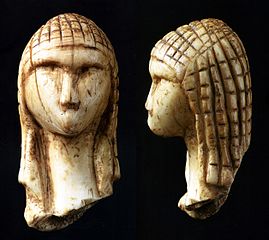Join Augustin, Alex, Lisa and the whole ArkeoTopia team to discover additional resources for step 8.1 in My Archaeology Book on archaeological research and the tourism economy, as well as the work of tour guides.
Step 8.1 – Practical Applications of Archaeology
Discovering Cultural Heritage
Corresponding pages in MAB1 and MAB2
MAB 1, p. 35 and MAB 2, pp. 42-43
More about this step’s reference artifact

 The drawing in My Archaeology Book titled Discovering Cultural Heritage was inspired by the Venus of Brassempouy. Discovering our cultural heritage is one of the most important practical applications of archaeology to everyday life, as this work fuels local economies as well as brings rise to other professions, such as that of the tour guide.
The drawing in My Archaeology Book titled Discovering Cultural Heritage was inspired by the Venus of Brassempouy. Discovering our cultural heritage is one of the most important practical applications of archaeology to everyday life, as this work fuels local economies as well as brings rise to other professions, such as that of the tour guide.
For this reason, neither Alex nor Lisa are depicted in the image, and instead a museum guide can be seen leading the school group on a visit.
The promotion of cultural heritage is also responsible for the advent of other professions, such as museum curators who are in charge of coordinating access to archaeological remains. There are also cultural arts managers and curators, whose work involves helping the general public understand not only the archaeological remains themselves, but also the work of archaeologists as a whole.
Here, the guide is explaining that the Venus of Brassempouy, also called “Lady with the Hood”, should not be confused with The Venus of La Poire. The Venus of Brassempouy is a fragment of an ivory statuette that stands 3.65 cm high and was discovered at the Grotte du Pape (Brassempouy, Landes) in 1894 during Édouard Piette’s excavations in the Gravettian era layers. Belonging to the Upper Paleolithic period, this statuette was dated to around 21,000 BCE, thus constituting one of the oldest realistic depictions of the human face. Today, the original is still on display at the National Archaeological Museum (inv. MAN no. 47.019), formerly the Musée des Antiquités Nationales, located at the Château Vieux de Saint-Germain-en-Laye. This museum is home to the Piette room, where the bust discovered by Edouard Piette pictured here, the Venus of Brassempouy, as well as an entire set of flint and bone tools and objects, exemplifying the technical and artistic skills of prehistoric human beings, are on display.

 In the image, the class is discovering this ancient artifact and its recent history under the benevolent but attentive eye of Bastet the cat. Bastet is seen here watching over the cultural heritage in the museum. Bastet also represents the calm atmosphere necessary in a museum in order for visitors to fully appreciate the cultural heritage. A calm atmosphere is also needed to ensure the artifacts in the museum remain well preserved and protected.
In the image, the class is discovering this ancient artifact and its recent history under the benevolent but attentive eye of Bastet the cat. Bastet is seen here watching over the cultural heritage in the museum. Bastet also represents the calm atmosphere necessary in a museum in order for visitors to fully appreciate the cultural heritage. A calm atmosphere is also needed to ensure the artifacts in the museum remain well preserved and protected.
Understanding the value of archaeological research as well as cultural heritage as part of the tourism economy is no easy task, as these are difficult things to quantify. This challenge is discussed in detail in the book by Ilde Rizzo and Anna Mignosa, Handbook on the Economics of Cultural Heritage published in 2013. Nonetheless, it is important to note that museum visits for archaeological collections in France as well as entrance fees to visit other archaeological sites and the curation of these activities easily represents revenues in the tens of millions of euros.
Clues
The 5 clues includes:
- Nestor the guide, as named on the badge hanging from his neck
- The guide’s headset and the visitors’ headphones, indicating that a discussion is in progress
- The visitors, in this case a school group chaperoned by a teacher
- The display case protecting the artifact, its label, as well as the other remnants surrounding it
- Bastet the cat
In addition to the work of museum guides and curators as represented in the image, Bastet the cat illustrates the additional responsibility afforded to museum guards. These professionals are equally as important in the effort of valuing our cultural heritage, and can see in the cat’s posture the calm demeanor necessary to uphold when visiting a museum.
Oral PresentationsMy Archaeology Book
Resources HomepageStep 8.2 – Using Archaeo
Learning History



